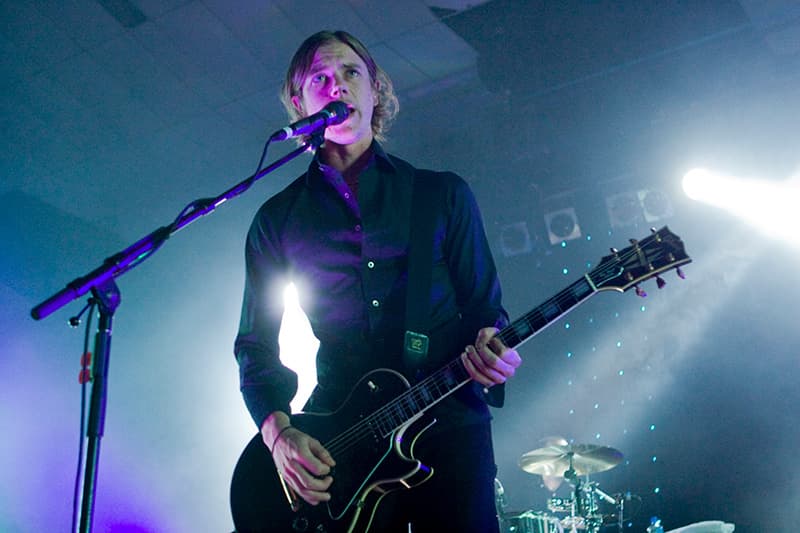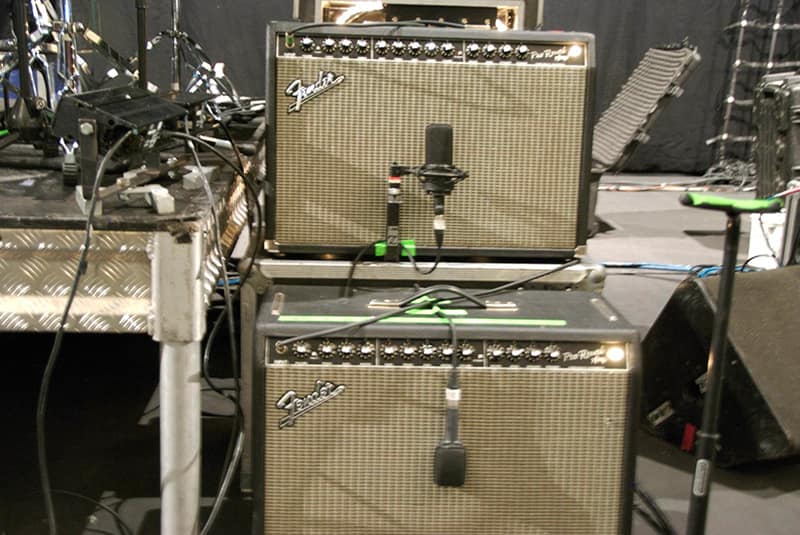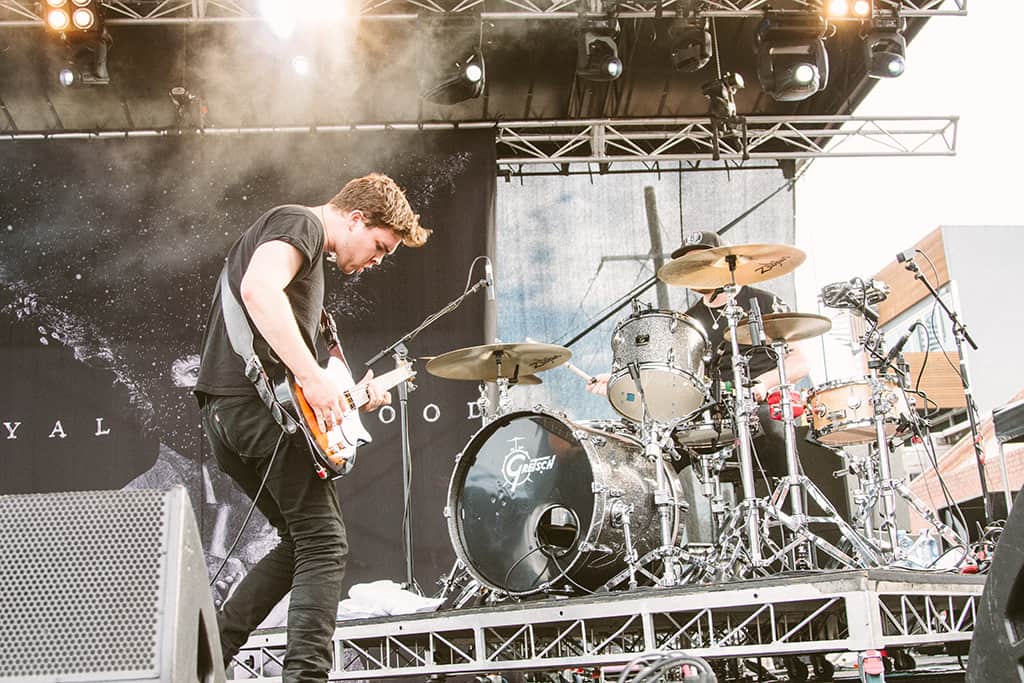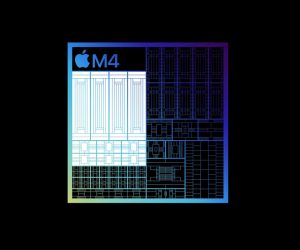
- Home
- /
- Feature
- /
- Live Sound
- /
- Plugged In: Next Level Live Guitars
Plugged In: Next Level Live Guitars
These live engineers do more than just point a ’57 at a guitar cab.
By Mark Davie
24 December 2015
Live Images: Marty Philbey
Touring guitar setups can sometimes require little more than an SM57 on an amp clamp and a couple of pieces of fluoro-coloured tape to mark out the sweet spot. But these days, guitarists can cover a lot of sonic ground, necessitating a whole new level of attention in the mix.
We talked to the engineers behind three of the more creative live guitar setups going around at the moment — Kevin Parker from Tame Impala’s dual attack, main and synth guitar setup; Nick Zinner from Yeah Yeah Yeah’s five-way, five amp monstrosity; and Mike Kerr from Royal Blood’s rig that turns one bass into the band’s entire multi-octave, full-width melodic instrumentation. We also touched base with the mix engineers for Calling All Cars and Against Me about using multiple mics to get a truly solid rock ’n’ roll guitar sound, and live sound legend John Kerns chips in his tried and true techniques for reinforcing guitars.


KEVIN PARKER, TAME IMPALA
Adam Round: “I’ve been mixing Kevin since early 2014. Without giving it all away, Kev uses two setups live. One is a ’67 Rickenbacker 330 through a tweed Vox AC30HW, this also has a switchable DI output that goes through a Radial J48 to me and feeds a Roland KC330 (for stage monitoring only), Boss GT 100 (MIDI synced for in-time delays), EH Holy Grail, Bogner Wessex, various modulation effects, and a MXR Dynacomp at the end of the chain.
“The Synth guitar setup is a Roland GK pickup on a Squier Jaguar with various modulation effects into a Yamaha MG06 mixer — cranked for the fuzz — and a Radial J48 DI.
“When I came on board there was a lot of noise coming off stage. Having a compressor at the end of the chain that’s doing heavy gain reduction presents many technical issues but sounds so cool. We went through each pedal in the chain to maintain correct gain structure as much as possible which gave us much better signal-to-noise. We upgraded all the DIs and also DI’d the Roland KC330 rather than miking it. This got it to sound much more like the album’s guitar sounds. We still have various AC hum and earthing issues daily which are resolved with lifting earth on the DI or splitter in one of several spots on stage and using hum eliminators.
“In all aspects of the mix we’re trying to go for a bigger, amplified version of the albums. I use a Sennheiser e906 mic on his cab. I find I get what I need out of most setups with a single mic. In live situations multiple mics on guitars can often be impossible to get right because of the comb filtering that occurs. If the two mics aren’t aligned exactly and both panned to the same area of a mix it can often completely change the sound of the guitar. We’ve worked so hard getting it right on stage so I don’t want to be changing the source guitar sound too much.
“I EQ room by room, and always use high- and low-pass filters to remove the unwanted low and high frequency areas that just compound and reduce headroom.
“One of the US tours we did this year we were unwrapping our freight and noticed that the forklift had completely crushed Kev’s main pedal board. The case and most of the pedals have been replaced throughout the year as they fail. Lucky enough we carry spares of most of the pedals.”
NO DOUBT, KANYE, GURRUMUL
John Kerns: “I’ve been pretty lucky throughout my career of working with folk that had their guitar sounds pretty dialled in to what they wanted. Unless something really doesn’t work for me, I won’t change their world. It’s their vision after all — I’m just hired to present it.
“If there are cabinets (and not Kempers or other modellers) I will usually start with several of the same microphone: Audio-Technica ATM650, Shure SM57 or Sennheiser MD409 for dynamics, and Audio-Technica AT4047 or AT4050 for condensers. I’ll typically create a stereo subgroup for all guitars (or a stereo sub per guitarist) and strap a Fatso Jr. across the insert of the subgroup. That way, the guitar cruises along in its place just fine until it’s solo time. Then, as I push the VCA or fader up, I get a more compressed ‘in your face’ sound without really adding volume, per se.
“I still prefer the sound of guitars moving air through paper cones. So if possible, I like to have an amp, running at a decent volume, pointed somewhere other than at me or the punters. There is a sound you just can’t seem to get without the cones moving air. I’m not a fan of iso-cabs though. Once they reach critical volume, they just seem to close up and lose any dynamics.”
HAYDN ING, CALLING ALL CARS
Mick Aarons: “Haydn typically uses a Fender Telecaster in a Fender Bassman with plenty of pedals in his chain. I didn’t really have any issues to fix, except for Haydn breaking his shit all the time. He went through a guitar and microphone destroying phase for a while. I’m really trying to get a full sound. They’re a three-piece so I want lots of low-mid in the guitar and I’m rolling off the top end. I love the wall of sound thing. I f**king hate mixes where only the kick drum and vocals are loud, and bass and guitar get left out.
“I stick a Shure SM57 on the front and a Beyer M88 in the back, phase flipped and low passed for a nice low mid boost to the sound. I mix it really, really loud — but good loud, not bad loud. One of Haydn’s worst/funniest in retrospect moments on tour was when he threw his amp off the stage at Big Day Out in Sydney then ran into the crowd and got knocked out by a punter. He was taken in an ambulance to hospital for stitches… it was a short gig.”
I played around with the Midas Pro2C’s little phase alignment tool for 45 minutes once, but it made it sound weird. We just use amp clamps to get the positions right



There is a sound you just can’t seem to get without the cones moving air
NICK ZINNER, YEAH YEAH YEAHS
Harley Zinker: “I worked with Nick Zinner in 2009-2010 on the It’s Blitz! tour. Nick has a really interesting setup. As well as quite an elaborate pedal board, he used five amps; four set up on stage left as a high/low/main/sampler and one on stage right.
“It was mostly Fender Twins or Pro Reverbs with an Ampeg 4×10 and an Ampeg head for the low amp. The sampler amp got a sub mix of Nick’s loop pedals in addition to DIs, but I used quite a bit of the amp channel as it was the sound Nick was going for.
“With five amps and a lot of pedals, there was a lot going on. I relied on Jesse Quitsland — Nick’s guitar tech — to chase down the buzzes, hums, phase and ground issues. He is an amazing tech and had the rig running as quiet and stable as possible. After that it was a matter of learning, and in some cases taking console snapshots of the various patches each song would use. Even so, shows could change quite a bit from one to the next so I had to be on my toes and ready to ride channel gains.
“My goal was to take what Nick, Brian [Chase, Drummer], Karen [O, Vocalist] and Pajo [Bass] were doing and make it bigger. They gave me great, strong, heartfelt performances each night. They presented it as it was supposed to sound. I stayed true to that and expanded on it sonically.
“I used mostly Shure SM57s on guitars, a Sennheiser E609 on the sampler amp and a Shure Beta 52 on the low amp. I remember at one point integrating a Cascade Fat Head ribbon in there but the stage volume was just too much.
“I assigned all five channels to a group, each with high-pass filters engaged but little if any EQ. There was no compression on the channels but there was a compressor over the group with slowish attack and a low ratio. I was barely hitting the comp, just doing enough to get all those sounds to gel and sound more cohesive through the PA.
“The guitars are very prominent in the mix. Nick isn’t always playing traditional guitar sounds and quite often a sound he sampled and processed would form the underlying basis of a song. I just put on It’s Blitz! recently, and was reminded of what an amazing record it is, and what an amazing band they are. The band were just amazing every night and I had a great time mixing them. They are deceptively simple from a mix perspective until you have to try and make room for all the subtleties. That’s what made it both a challenge and fun.
“On another note I have to mention Aaron Hemphill, guitar player for Liars. I have been a fan of the band for years and got to workbench them on a few tours years back, somewhere around 2006 when Drum’s Not Dead was released. Aaron is simply amazing, he can go from zero to 100 in a blink, he’s such a creative player when it comes to his tone, and a lovely guy to boot.
“The most underrated guitar player I’ve worked with is Paul Banks from Interpol. Daniel Kessler gets a lot of the attention for his guitar playing and people don’t always give Paul his dues, but he’s as solid as they come for a guitar-playing frontman. I just finished up a year and a half of touring with Interpol in support of El Pintor. A lot of touring but a lot of fun. Right now, I’m looking for my next mixing adventure.”

MIKE KERR, ROYAL BLOOD
Vocalist Mike Kerr plays short-scale basses through a pedal chain centred around a couple of Electro-Harmonix POGs that make his instrument sound like a guitar, bass or both at the same time. Company policy says Jones can’t dish the specifics.
The result gets split across two Fender guitar amps and a bass amp with a dynamic and condenser on each guitar amp — a Shure SM57 and an Audio-Technica 4060 tube mic.
Phil Jones: “The first amp is hard-panned left/right, and the other one is right/left and acts as a thickener. It doesn’t sound panned, it’s just wide. There’s absolutely no delaying or phase. I played around with the Midas Pro2C’s little phase alignment tool for 45 minutes once, but it made it sound weird. We just use amp clamps to get the positions right.”
AGAINST ME!
Scott Edwards: “There’s been a lot of trial and error with microphones. I love the Heil PR30s for my guitar mics. And I also use the Palmer DIs with the speaker emulation between the amp and the cab. It gives me a good basic sound, and I see the mics as my lead — if I want to ride anything, I ride the mics up. The Heils are really flat, full and nice. I don’t need to add anything to them, they’re just present. There’s also 40dB of rejection out the back of them, so you don’t get a lot of drum noise or anything like that.”

















RESPONSES